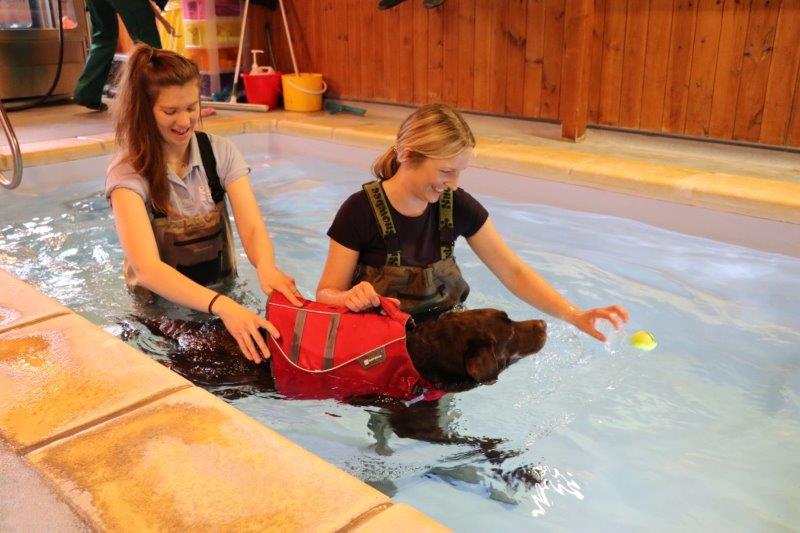Small Animal Hydrotherapy
Clinical Connections – Summer 2018
We interview Helen Webb, Senior Neurology and Rehabilitation Nurse at the RVC, who has 12 years’ experience delivering hydrotherapy to pets and a Level 3 Certificate in Canine Hydrotherapy and works hand in hand with our veterinary physiotherapy specialist, Emily Cowderoy. The RVC delivers hydrotherapy in a purpose-built centre next to the Queen Mother Hospital for Animals. An underwater treadmill was updated this year. The Veterinary Physiotherapy and Rehabilitation Service works closely with the Neurology and Neurosurgery Service, as well as other clinical teams, to ensure the best possible outcome for each patient.
How long have you worked in this area?
I have worked for the Hydrotherapy Service, part of RVC’s Veterinary Physiotherapy and Rehabilitation for over 12 years.
How big is the RVC hydrotherapy team?
There are eight in our immediate team – working shifts as we have appointments going until the evenings most days.
How busy is the service?
We would typically do up to 15 treadmill cases in a day and five pool sessions.
Who uses this service?
As well as handling referral cases from the wider vet community, we provide support to our RVC small animal colleagues. Often cases combine number of our services such as orthopaedics, neurology and neurosurgery, physiotherapy and our sports medicine clinic.
Which species do you work with?
95% of our cases are dogs but we also work with cats.

What are the conditions you treat most often?
The most common cases we see are hip dysplasia, elbow dysplasia, spinal surgery recovery, intervertebral disc displacement and fibrocartilaginous embolism. We also see quite a lot of animals for weight management, pain management, balance training and mental health and wellbeing.
What are the main benefits of using hydrotherapy for recovery and rehabilitation?
As it is a non-weight bearing activity there is less stress and pressure on the pet yet extra resistance from the water increases and accelerates muscle build. It is a low risk way to build up improved mobility and warm water provides a comfortable environment for pet recovery.
How does the hydrotherapy treadmill help with pet treatment?
We have control over the water levels, temperature and treadmill speed. This enables us to set it up to suit the needs of the specific case we are dealing with. We can even set up the treadmill with an incline to increase effort if needed. The treadmill computer enables us to store and monitor the pet’s progress for each session and across a series of sessions. This provides us vital data to adjust the recovery programme plan as we go along. These outputs can be shared with the referring vet as part of the pet’s ongoing health management.
What do you think the future of hydrotherapy will look like?
Whilst we are witnessing significant pet health improvements as a direct result of their sessions with us, we want to be able to quantify the benefits we are delivering and there is the need for more research into the benefits of hydrotherapy in pet recovery and treatment. Benjamin Mielke, a surgical specialist-in-training at the RVC, is currently undertaking a study that is measuring the impact of hydrotherapy on tibial-plateau-levelling osteotomy recovery. More research of this type will help us refine what we do and veterinary professionals advocate the approach more to clients. We find that our pet owner clients are our most passionate advocates – and our team loves being part of their treatment and recovery journey.
